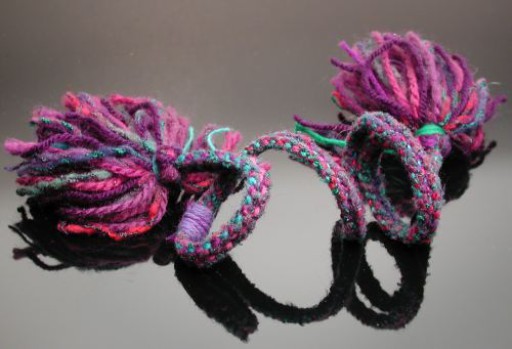You know all those little essays people like to write–people as dogs, people as knitters, people as fruit, people as ice cream—whatever. Well, normally I find them pretty silly, but I have to admit my friend Page, whose favorite color combination is purple and green, has an infallible radar for any item of adornment or textile well rendered in this scheme. And the nubbly, textured yarn, exotic, unusual, beautiful (and maybe not altogether practical) perfectly exemplifies her artistic vision. And she was kind enough to give this fabulous yarn to me, instead of keeping it.
As a rule I think highly textured braids tend to hide the beauty of kumi; and my feeling is, if you're gonna use ’em, use em on a simple, decisively shaped braid. And I simply couldn't resist this yarn.
This one might be mitake from Martin's book, it might be one of owen's square braids...I no longer recall. Of all the media I've tried, I'd say braiding by far demands the greatest note taking. I can sort of recreate beads—sample strings of all the glass I have really helps—and embroidery is a matter of getting the motor control back, and stringing is pretty straightfoward, if you've at least got a picture of the item—but kumi's tough. Especially if only pursuing a craft on a sporadic basis, as I do kumi, I highly recommend making notes and keeping a sample swatch, even though it's a chore and a bore.

What I do remember is that the inexpensive fuscia pink yarn was too dominant in the design, so I cut it out and substituted a finer, more color saturated (and better quality) yarn. You can see this difference in the picture; the coarser yarn is on the left; the finer, more brilliant fuscia on the right. The transition between them is marked by the lavender purple wrap.
cotton and synthetic fibers
Unless otherwise noted, text, image and objects depicted therein copyright 1996--present sylvus tarn.
Sylvus Tarn